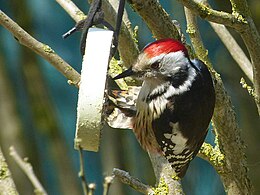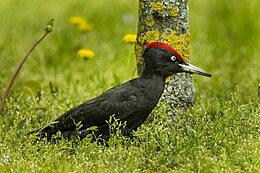Johanniterwald (bird sanctuary)
|
Bird sanctuary (SPA) "Johanniterwald"
|
||
| location | Kenzingen and Rheinhausen , Emmendingen district , Baden-Württemberg , Germany | |
| WDPA ID | 555537916 | |
| Natura 2000 ID | DE-7712-403 | |
| Bird sanctuary | 57.548 ha | |
| Geographical location | 48 ° 12 ′ N , 7 ° 44 ′ E | |
|
|
||
| Setup date | November 20, 2007 | |
| administration | Regional council Freiburg | |
The Johanniterwald area is a European bird sanctuary (protected area identifier DE-7712-403) in the Baden-Württemberg district of Emmendingen in Germany, which was designated by ordinance of November 20, 2007 by the Freiburg Regional Council .
location
The approximately 58 hectare (ha) large bird sanctuary "Johanniterwald" is divided between the two communities Kenzingen (97.14% = 55.91 ha) and Rheinhausen (2.85% = 1.64 ha). It is located three and a half kilometers southwest of Herbolzheim , around three kilometers northwest of Kenzingen and borders immediately to the west on federal motorway 5 . In the northeast it borders on the bird sanctuary " Elzniederung between Kenzingen and Rust ".
description
The protected area "Johanniterwald" is described with "oak-hornbeam forests and other tree species compositions appropriate to the location in the valley of the Elz as a habitat for a bird world worthy of protection".
meaning
The bird sanctuary "Johanniterwald" is one of the most important breeding areas for the black kite in Baden-Württemberg.
Habitat classes
| Deciduous forest | 100% | |||
Protection purpose
The area-related conservation objectives are described differently depending on the species :
Breeding birds
Breeding bird species that are listed in Appendix I of the Birds Directive and for which special measures are to be applied across Europe. A total of 39 species fall into this category in Baden-Württemberg and three species in the "Johanniterwald" protected area .
Middle Woodpecker ( Dendrocopos medius )
Preservation of deciduous and mixed deciduous forests, especially those with oak, of alluvial and alder forests, of extensively cultivated orchards, of old trees and islands of old wood, of standing dead wood and trees with caves.
Black kite ( Milvus migrans )
Preservation of diversely structured cultural landscapes, of sparse forests, in particular alluvial forests, of field trees, large individual trees and rows of trees in the open landscape, grassland, islands of old wood and old, large-crowned trees with free approach, especially near the forest edge, preservation of natural flowing and still waters, conservation of trees with clumps, of habitats without sources of danger such as non-bird-safe overhead lines and wind turbines as well as maintenance of undisturbed or at least undisturbed breeding sites during the breeding season from March 1st to August 15th.
Black Woodpecker ( Dryocopus martius )
Preservation of extensive forests, old trees and islands of old wood, dead wood, preservation of trees with large caves as well as the food supply, especially with ants.
Migratory birds
Other migratory bird species not listed in Appendix I that breed in the country and have been selected for the protected areas. A total of 36 species fall into this category in Baden-Württemberg; No species is recorded in the “Johanniterwald” protected area.
Contiguous protected areas
The bird sanctuary "Johanniterwald" includes the bird sanctuary " Elzniederung between Kenzingen and Rust " (7712-402), the FFH area " Taubergießen, Elz and Ettenbach " (7712-341), the nature reserve " Johanniterwald " (3.110) and the landscape conservation area "Johanniterwald" (3.16.008) designated as contiguous protected areas.
See also
Web links
- Ordinance, data evaluation sheet and map in the profile of the SPA area in the LUBW's protected area directory
Individual evidence
- ↑ Ordinance of the Ministry of Food and Rural Areas establishing European Bird Protection Areas (VSG-VO) of February 5, 2010
- ↑ Profile of the SPA area in the protected area directory of the LUBW , with "Bird Protection Area Ordinance Annex 1"



